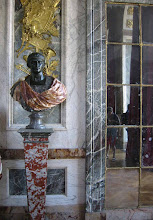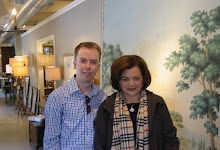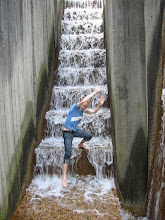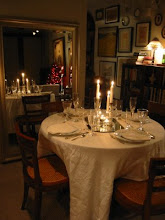
Much like it's neighbor, Versailles (which it is said to have had the first room dedicated entirely to private dining, setting the fashion), the Petit Trianon has a devoted dining room. The room is one of two with a crystal chandelier instead of the more typical lantern.

The dining room, seen here in blue, lies just above the
anteroom, the first room in the set of apartments.

One of the most famous stories about the PT is that the dining room had a mechanical dining table which rose out of the floor from the kitchen below. This way, dinner guests did not need to be waited on by servants and could eat in private. Unfortunately, the table was never completed but the foundation for the device was built and can still be seen in the basement.

The dining room is set on direct axis with the
French Pavilion, seen through the windows above. French houses always seem to have
the view as an important end goal: whether seen through an enfilade of rooms or at the end of an allee of trees. I think this is one of the reasons that the French style of architecture remains so popular: great views make for great spaces.

The dining room features some handsome dark wood chairs. Out of all of the rooms, the dining room felt the most masculine and the most strongly neoclassical, despite the red silk curtains!

A beautiful bust of Marie Antoinette rests above the fireplace in front of a large mirror. Directly across the room, between the french doors is an identical mirror. As meals would be eaten here by candelight, magnifying the light from the precious candles was of utmost importance. I suppose that is the practical reason for the crystal and the mirrors, but the glamour factor must have been part of the decision as well! To this day, dining rooms tend to be the most glamorous room in any house.

I just couldn't get over how beautiful all of the door hardware was and even the doors themselves so I'll end here with another great door shot! Also notice the beautiful Parquet de Versailles styled floors.
 Much like it's neighbor, Versailles (which it is said to have had the first room dedicated entirely to private dining, setting the fashion), the Petit Trianon has a devoted dining room. The room is one of two with a crystal chandelier instead of the more typical lantern.
Much like it's neighbor, Versailles (which it is said to have had the first room dedicated entirely to private dining, setting the fashion), the Petit Trianon has a devoted dining room. The room is one of two with a crystal chandelier instead of the more typical lantern. The dining room, seen here in blue, lies just above the anteroom, the first room in the set of apartments.
The dining room, seen here in blue, lies just above the anteroom, the first room in the set of apartments. One of the most famous stories about the PT is that the dining room had a mechanical dining table which rose out of the floor from the kitchen below. This way, dinner guests did not need to be waited on by servants and could eat in private. Unfortunately, the table was never completed but the foundation for the device was built and can still be seen in the basement.
One of the most famous stories about the PT is that the dining room had a mechanical dining table which rose out of the floor from the kitchen below. This way, dinner guests did not need to be waited on by servants and could eat in private. Unfortunately, the table was never completed but the foundation for the device was built and can still be seen in the basement. The dining room is set on direct axis with the French Pavilion, seen through the windows above. French houses always seem to have the view as an important end goal: whether seen through an enfilade of rooms or at the end of an allee of trees. I think this is one of the reasons that the French style of architecture remains so popular: great views make for great spaces.
The dining room is set on direct axis with the French Pavilion, seen through the windows above. French houses always seem to have the view as an important end goal: whether seen through an enfilade of rooms or at the end of an allee of trees. I think this is one of the reasons that the French style of architecture remains so popular: great views make for great spaces. The dining room features some handsome dark wood chairs. Out of all of the rooms, the dining room felt the most masculine and the most strongly neoclassical, despite the red silk curtains!
The dining room features some handsome dark wood chairs. Out of all of the rooms, the dining room felt the most masculine and the most strongly neoclassical, despite the red silk curtains! A beautiful bust of Marie Antoinette rests above the fireplace in front of a large mirror. Directly across the room, between the french doors is an identical mirror. As meals would be eaten here by candelight, magnifying the light from the precious candles was of utmost importance. I suppose that is the practical reason for the crystal and the mirrors, but the glamour factor must have been part of the decision as well! To this day, dining rooms tend to be the most glamorous room in any house.
A beautiful bust of Marie Antoinette rests above the fireplace in front of a large mirror. Directly across the room, between the french doors is an identical mirror. As meals would be eaten here by candelight, magnifying the light from the precious candles was of utmost importance. I suppose that is the practical reason for the crystal and the mirrors, but the glamour factor must have been part of the decision as well! To this day, dining rooms tend to be the most glamorous room in any house.





















.jpg)





















.JPG)







































































15 comments:
These tours are so good, the floor plans help me make sense of it all. Thanks so much for these.
the plan's so simple but so intricate in details=)
I recall these 'Jacob' chairs to be the ones that were part of a suite for the Neo-classical Laterie at RAMBOUILLET...built by Louis XVI to entice Marie Antoinette to love the Chateau. It is a most beautiful Temple, magnificent in detail with a coffered Rotunda under which a tempietto with marble statues of Almathea and the goats, cascades and runnels where the milk was moved and chilled with a center marble table inlaid with Napoleon's cipher, for hers was destroyed during the Revolution.
I may be wrong and these might be THE chairs for PT, but I recall the rage and impetus for them was Maria Carolina, Queen of Naples who had just discovered/uncovered Pompeii and Herculaneum...Marie Antoinettes' sister.
Just love those Crimson Red Silk unlined draperies...much like Chatsworth!
Oh, I really needed all of this light and bright on a cold snowy day...
i would love to paint the last image.
how divine this post is!!!!
xx
I can help you ID the pair of marble busts in anteroom...both are by BOIZOT, one of Louis XVI and the other Emperor Joseph II, Marie Antoinette's brother. These men were THE most important to her, and of course, they were prominently displayed, France and Austria in harmony.
This is a wonderful mirage during the rains here in Pasadena...if I ever win the lotto, I am calling you to help recreate the PT! Your Soul is infused within this posting.
I enjoyed your posts of the last days! The beautiful tablescape, the Petit Trianon pictures!!! Thank you so much for sharing this!
xx
Greet
I love the door hardware shot. I took a similar (although less opulent) shot at Edith Wharton's this summer. And yes, her hardware was imported from France. Gorgeous!
each image stefan demands a thorough study to grasp the exquisite details.
i once saw a bathtub circa 18thc for sale in paris. all of the inside wall plumbing was still attached. what took my breath away was the intricate carvings and details on the pipes.......never meant to be seen.
ah the french!
debra
I am so depressed that they never finished that table...the concept sounds absolutely magical! Or odd...I can't decide. Not sure how I would react to a fully set table appearing from the floor?
Thank you for such a wonderful tour> I had forgotten how magnificent the PT really is.The view from the dining room is superb.
thanks for sharing the pictures, the PT series is just wonderful!
Impressive and informative, as always. If you have any close-up photos of the wrought iron-work at P.T. I would love to see them.
David :-)
Lovely post, Stefan. (And I hope you're holding up well what with the results of that blizzard -- yikes.)
I was wondering if you've ever posted anything on the hidden staircases built into many a baroque palace, especially with regard to master bedrooms. The concept has always fascinated me, and it would be wonderful to see floorplans for such contraptions like hidden staircases and secret ante-chambers, etc.
Take care,
Michael
In Vienna, Marie Antoinette's mother had a dining table, in a small round chamber, with a device to lower it in the floor. So no servants were needed in the room itself, and she (Empress Maria Theresia) could have private meetings.
This particular room can be seen at the palace Schonbrunn/Vienna.
Bas/Netherlands
Post a Comment